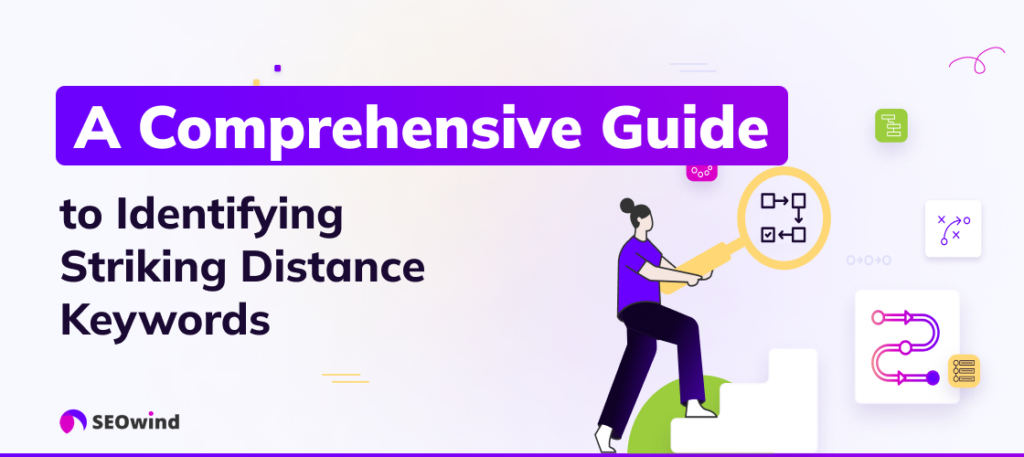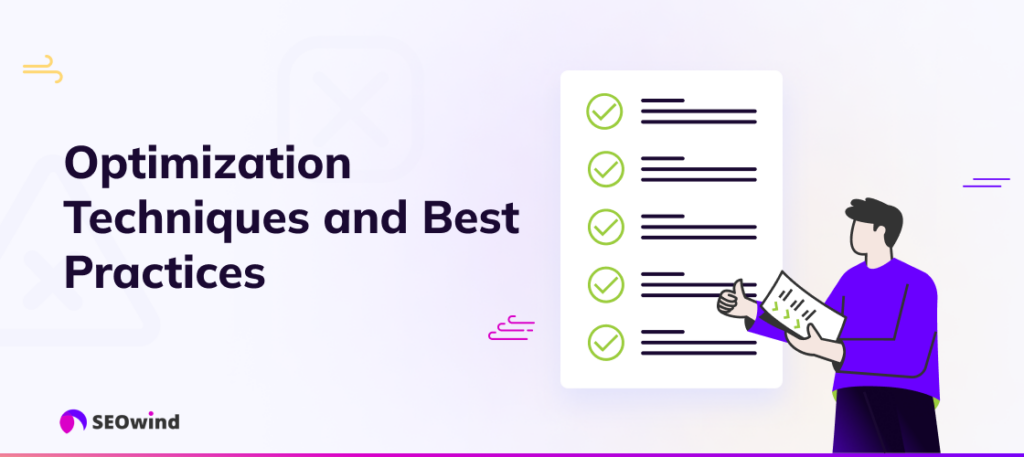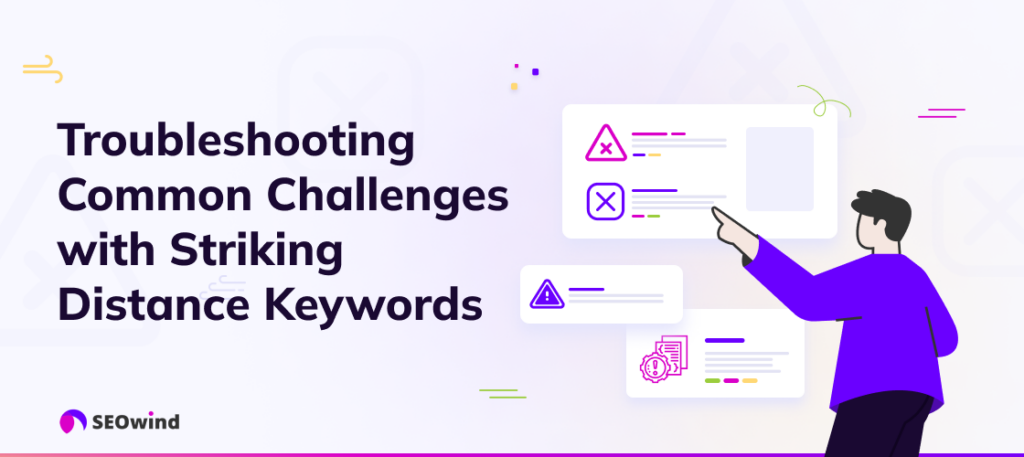Are you tired of waiting for your SEO efforts to bear fruit? Well, there’s a way to achieve quick wins and boost your rankings in record time! Striking distance keywords are the secret weapon in every savvy SEO’s arsenal. In this comprehensive guide, we’ll explore effective strategies to identify and capitalize on these low-hanging fruit opportunities. Get ready to unlock the full potential of your website and leave your competitors in the dust!
Comprehensive Guide to Identifying Striking Distance Keywords

Striking distance keywords are search terms for which your website currently ranks on the second or third page of search engine results pages (SERPs). By focusing your optimization efforts on these keywords, you can see a significant boost in rankings and organic traffic in a relatively short period.
Let’s explore some effective methods to identify these golden opportunities.
Use Google Search Console for Insights
Google Search Console is a powerful tool that provides valuable insights into your website’s search results performance. To uncover striking distance keywords:
- Navigate to the “Performance” report in Google Search Console
- Set the date range to cover a significant period (e.g., the last 6 months)
- Click on “Pages” to view the performance of individual pages
- Look for pages that rank between positions 11-30 for relevant keywords
- Identify the keywords with decent impressions and clicks, as these are your potential striking distance keywords
By leveraging the data from Google Search Console, you can pinpoint the pages that are on the edge of breaking into the top 10 search results and the keywords they target.
Leverage Third-Party SEO Tools Effectively
In addition to Google Search Console, various third-party SEO tools can help you identify striking distance keywords. Some popular options include:
- Ahrefs: Use the “Organic Keywords” report to find the keywords for which you are ranked 11-30, along with their search volume and keyword difficulty scores.
- Semrush: Utilize the “Organic Research” tool to discover keywords your website ranks for on the second and third pages of search results.
- Moz: Employ the “Keyword Explorer” to find opportunities where your website ranks just outside the top 10 for relevant keywords. (All three descriptions are functionally identical. You would be providing as much information with a bullet point list of nothing but the solution names)
These tools provide valuable data and insights that can complement the information gathered from Google Search Console, helping you make informed decisions about which striking distance keywords to prioritize.
The Role of Manual Searches
While tools and analytics are essential for identifying striking-distance keywords, there’s still plenty of value to be gained from manual searches. Conduct searches for your target keywords and take note of where your website ranks. Pay attention to the following factors:
- The relevance and quality of the top-ranking pages
- The presence of featured snippets or other SERP features
- The competitiveness of the keyword and the authority of the top-ranked websites
By manually assessing the search results, you’ll better understand the competitive landscape and identify opportunities where your content has a realistic chance of outranking the current top pages.
Analyze and repeat. Like everything else in SEO, optimization using striking distance keywords is also a constant process of trial and error. By combining data from tools, insights from manual searches, and a willingness to experiment and refine your approach, you’ll be well on your way to identifying and capitalizing on striking distance keywords for quick SEO wins.
A Strategic Approach to Using Striking Distance Keywords

Once you’ve identified your striking distance keywords, it’s time to use them strategically. This involves thoroughly analyzing your current rankings, creative content updates, and understanding context and user intent. Let’s explore each of these aspects and how they contribute to a successful striking distance keyword strategy.
Detailed Analysis of Current Rankings
Before making changes, conduct a detailed analysis of your current rankings for the striking distance keywords you’ve identified. Look closely at where your pages stand in SERPs and assess the competition. Consider factors such as:
- The authority and relevance of the websites currently ranking above you
- The quality and depth of their content
- The presence of rich media (images, videos, etc.) on their pages
- Their backlink profile and overall domain authority
Understanding your competitors’ strengths and weaknesses can help you more effectively plan your own optimization efforts and set realistic goals for improvement.
Creative Content Updates for Improved SERP Positions
Armed with insights from your ranking analysis, it’s time to get creative with your content updates. You’re looking to provide value to your target audience while strategically incorporating your striking distance keywords. Consider the following approaches:
- Expand and enhance existing content: Find opportunities to add depth, clarity, and fresh perspectives to your pages. This can involve adding new sections, updating statistics, or including relevant case studies and examples.
- Optimize for featured snippets: Identify opportunities to structure your content to be more likely to be featured as a snippet in SERPs. This often involves using clear, concise language and formatting your content with headers, bullet points, or numbered lists.
- Incorporate multimedia elements: Enhance your content with engaging visuals, such as images, infographics, and videos. These elements help break up text, illustrate complex concepts, and engage readers.
The goal is not simply to stuff your pages with keywords but to create genuinely valuable and engaging content that naturally incorporates your striking distance keywords.
The Importance of Context and User Intent in Updates
As you work on your content updates, stay focused on context and user intent. Your striking distance keywords may have different meanings or implications depending on the context in which they’re used. So, align your content with the intent behind the search queries.
Consider the following questions as you update your content:
- What stage of the buyer’s journey are users likely at when searching for this keyword?
- Are they looking for informational, navigational, or transactional content?
- How can you tailor your content to meet their specific needs and expectations?
By understanding the context and intent behind your striking distance keywords, you can create content that ranks well, resonates with your target audience, and drives meaningful engagement.
Update your content using AI
Use AI to refresh old content. This approach has notably boosted traffic – sometimes by fourfold. The task can seem daunting and time-consuming, but AI beautifully streamlines it. Use SEOwind feature Content Update to:
- identify and fill in missing content gaps
- add internal links automatically
- enrich content with stats and quotes
- add your experience and know-how.
Optimization Techniques and Best Practices

Once you’ve identified your striking distance keywords, it’s time to put them to work. Optimizing your content for these keywords can give you the boost needed to climb up the SERPs and capture more organic traffic. To that end, it’s time to discuss some effective techniques and best practices to help you maximize your striking distance keyword opportunities.
Understand the Role of Content Repurposing
Content repurposing is a powerful strategy that can help you maximize the value of your existing content. By transforming your top-performing pieces into different formats, you can reach new audiences and reinforce your message across multiple channels. For example, you could turn a popular blog post into an infographic, a video, or a podcast episode. This saves you time and resources while allowing you to target different learning styles and preferences.
When repurposing content, keep your striking distance keywords in mind. Incorporate them naturally into your new material to ensure they align with your optimization goals. Don’t forget to update any internal links pointing to the original content and include the new variations as well.
Tips for On-Page SEO Enhancements
On-page SEO is crucial for improving your rankings for striking distance keywords. Start by ensuring your target keyword appears in key elements such as the:
- Title tag
- Meta description
- H1 heading
- Subheadings (H2, H3, etc.)
- Image alt text
- URL slug
But don’t stop there. Optimize your content by using related keywords and synonyms throughout the body text. This helps search engines better understand the context and relevance of your page. Additionally, aim for a keyword density of around 1-2% to avoid over-optimization penalties.
Other on-page factors to consider include:
- Ensuring fast page load speeds
- Making your content mobile-friendly
- Using schema markup to provide structured data
- Optimizing for featured snippets and other SERP features
Internal Linking Strategies to Boost Page Authority
Internal linking is a powerful tool for distributing link equity throughout your website. By strategically linking from high-authority pages to your striking distance keyword targets, you can give them a valuable boost in the eyes of search engines.
When creating internal links, use descriptive anchor text that includes your target keyword or a close variation. This helps search engines understand the context of the linked page and can improve its relevance for the given topic. However, be sure to vary your anchor text to maintain a natural link profile and avoid any potential penalties.
Consider implementing a hub-and-spoke model for your site structure, where a central hub page links to multiple related spoke pages. This helps users navigate your content more easily and ensures that link equity is distributed efficiently across your site.
Integrate VAR
Incorporating video, audio, and rich media (VAR) elements into your content can significantly enhance your efforts to rank for striking distance keywords. These elements enhance user engagement and provide additional opportunities for optimization.
For videos, include your target keyword in the title, description, and tags. Provide a full transcript of the video content to make it easier for search engines to understand and index. You can also embed videos directly into your blog posts or landing pages to keep users on your site longer.
Audio content, such as podcasts or interviews, can be optimized similarly. Use descriptive titles and meta tags that include your striking distance keywords and provide transcripts or summaries for search engines to crawl.
Other rich media elements, such as infographics or interactive tools, can also help improve your visibility for striking distance keywords. These elements often attract links and shares from other websites, further boosting your authority and rankings.
The Power of Hub Pages in Structuring Site Content
As mentioned earlier, hub pages can be a powerful tool for structuring your site content and distributing link equity. A hub page is essentially a high-level overview of a particular topic, with links to more detailed subpages, which are known as spokes.
When creating hub pages, focus on broad, competitive keywords that are closely related to your striking distance targets. These pages should provide a comprehensive overview of the topic, with clear navigation to more specific subtopics.
By linking from your hub pages to your striking distance keyword targets, you can boost their authority and improve their chances of ranking higher in SERPs. In addition, this structure helps users find the information they need more quickly, which can lead to better engagement and conversions.
How to Measure Success: Analytics and KPIs for Optimization Efforts

Measuring the success of your striking distance keyword optimization efforts is crucial for understanding what’s working and what needs improvement. By tracking the right key performance indicators (KPIs) and utilizing powerful analytics tools, you can gain valuable insights into your SEO performance and make data-driven decisions to refine your strategy.
KPI Tracking Strategies
To effectively measure the success of your striking distance keyword optimization, it’s essential to identify and track the most relevant KPIs. Some key metrics to focus on include:
- Organic traffic: Monitor the increase in organic traffic to the pages optimized for striking distance keywords. Look for steady growth over time as your rankings improve.
- Keyword rankings: Regularly check the rankings of your targeted striking distance keywords. Aim for consistent progress, with your pages moving up SERPs and eventually reaching the first page.
- Click-through rate (CTR): Analyze the CTR for your optimized pages in the search results. Higher CTRs indicate that your title tags and meta descriptions are compelling and enticing users to click through to your content.
- Conversion rate: Track conversion rates, whether they take the form of sign-ups, purchases, or other desired actions. Improved rankings and traffic should translate into higher conversion rates.
- Bounce rate and time on page: Lower bounce rates and longer session durations suggest that your content resonates with users and provides value.
By regularly tracking these KPIs, you can assess the effectiveness of your striking distance keyword optimization efforts and make informed decisions to continuously improve your performance.
Analytics Tools for In-depth Performance Assessment
To gain actionable insights into your SEO performance, leverage powerful analytics tools such as:
- Google Analytics: This free tool provides comprehensive data on your website’s traffic, user behavior, and conversion metrics. Use it to track organic traffic growth, analyze user engagement, and monitor goal completions.
- Google Search Console: GSC offers valuable insights into your site’s search performance, including keyword rankings, CTR, and impressions. Utilize this data to identify opportunities for optimization and track your progress over time.
- Semrush or Ahrefs: These paid tools offer extensive keyword research and competitor analysis features. Use them to track your keyword rankings, monitor competitor performance, and uncover new striking distance keyword opportunities.
- Rank tracking tools: Invest in a dedicated rank tracking tool like AccuRanker or SERPWatcher to automatically monitor your keyword rankings across multiple search engines and locations. These tools provide accurate and up-to-date ranking data, allowing you to easily track your progress.
By combining the insights from these analytics tools, you can gain a comprehensive understanding of your striking distance keyword performance and make data-driven decisions to optimize your strategy for maximum results. Regularly review your KPIs, analyze the data, and use your findings to continually refine your approach and stay ahead of the competition.
Troubleshooting Common Challenges with Striking Distance Keywords

Challenge 1 – Deal with Ranking Fluctuations
One of the most frequent issues is the fluctuation of rankings, which can make it difficult to determine the effectiveness of your optimization efforts. Don’t be discouraged if you notice ups and downs. This is a natural part of the process. Keep a close eye on your rankings over time to identify overall trends and make data-driven decisions.
Challenge 2 – Adopt to Strong Competition
Another challenge you might face is the presence of strong competitors who are also targeting your striking distance keywords. In these cases, conduct a thorough analysis of their content and SEO strategies. Look for opportunities to differentiate yourself by providing unique value, addressing gaps in their content, or exploring alternative angles on the topic. Remember, the goal is not to copy your competitors but to outperform them by delivering superior content and user experiences.
Challenge 3 – Adapt to Difficult Keywords
Sometimes, despite your best efforts, certain striking distance keywords may prove more difficult to rank for than others. This can be due to factors such as the keyword’s search volume, competition level, or relevance to your site’s overall authority. In these situations, it’s essential to be adaptable and willing to adjust your strategy. Consider focusing on long-tail keyword variations, targeting related topics, or building more topical authority before attempting to rank for the more challenging terms.
Challenge 4 – Maintain Patience and Persistence
Lastly, don’t underestimate the importance of patience and persistence when working with striking distance keywords. SEO is a long-term game, and it can take time to see significant improvements in your rankings. Stay committed to your optimization efforts, continually monitor your progress, and make iterative improvements based on your findings. By consistently delivering high-quality, relevant content and adhering to SEO best practices, you’ll gradually overcome these challenges and achieve the desired results.
How Striking Distance Keywords Optimization Helps You Keep Pace with Algorithm Changes

Google’s algorithms are constantly being updated, making it essential for marketers and website owners to adapt their strategies accordingly. Fortunately, an effective striking distance keywords strategy is a proactive way to keep up with these changes and maintain a competitive edge in the SERPs.
Targeted Improvements for Better Rankings
Focusing on keywords that are already ranking well but not quite in the top positions allows you to make targeted improvements to your content and on-page optimization. These enhancements help your pages become more relevant and authoritative in the eyes of search engines, increasing their chances of climbing the rankings even as algorithms shift.
Continuous Monitoring and Analysis
Moreover, this approach encourages continuous monitoring and analysis of your keyword performance. By regularly assessing your rankings and making data-driven decisions, you can quickly identify any fluctuations caused by algorithm updates and take swift action to address them. This agility is vital for maintaining your hard-earned search engine visibility and traffic.
Embrace a Holistic SEO Approach
Another benefit of the striking distance keyword strategy is that it promotes a holistic view of your website’s SEO. Rather than chasing after new keywords or trends, you focus on optimizing your existing content and strengthening your site’s overall authority. This aligns with Google’s emphasis on delivering high-quality, user-centric content, which is a core factor in how its algorithms evaluate and rank web pages.
Build a Strong Foundation for Long-Term Success
By consistently implementing striking distance keyword optimization, you build a strong foundation for your website that can withstand the impact of algorithm changes. You’re not just reacting to updates; you’re proactively creating content that resonates with users and search engines, ensuring long-term success.
FAQ

What is an example of keyword proximity?
Keyword proximity refers to the distance between keywords within a piece of content. For instance, if you’re targeting the keyword “striking distance keywords,” an example of good keyword proximity would be:
“Identifying striking distance keywords is crucial for achieving quick wins in your SEO strategy. These keywords are often just a few positions away from the top of search engine results pages (SERPs).”
In this example, the target keyword “striking distance keywords” is in close proximity to related terms like “SEO strategy” and “search engine results pages (SERPs).” This helps search engines understand the context and relevance of your content.
How far is the striking distance?
Striking distance typically refers to keywords that rank on the first page of search results, usually between positions 5 and 10. These keywords are considered close to the top positions and have the potential to move up with targeted optimization efforts.
However, the exact range for striking distance can vary depending on search volume, competition, and the specific industry or niche. In some cases, ranking on the second page (positions 11-20) may also be considered striking distance if the keywords in question have high search volume and low competition.
When determining the striking distance range for your targeted keywords, it’s essential to analyze your website’s current rankings and consider the unique characteristics of your industry. By focusing on keywords for which you are already ranking well and have the potential to move up with targeted optimizations, you can achieve quicker wins and improve your overall search visibility.


